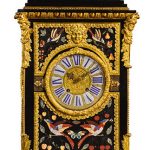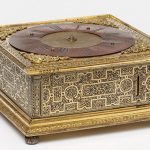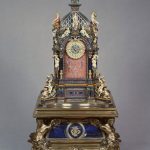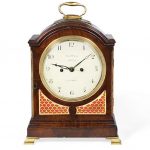Table Clocks. A table clock is a special watch type. Many of the early mechanical clocks hung on walls or were standing on wooden boxes in which the weights wound down. In the 15th century the first spring-driven table clocks arose, which – as the name suggests – found their place on tables or other furniture. Characteristic of the 16th and 17th century was the tower clock with costly decorated case, often in gilded bronze and mostly standing on metal bases or black painted wood. To this time of the early Baroque belonged also the figure clocks, where artfully crafted figurines such as animals, wagons and ships were playfully connected to movements and repetitions. Augsburg, Germany, remained leader in the production of puppet and automaton clocks until the 18th century.
The table clock is still preserved and is produced in numerous variations. Nowadays, it is often less about technology than about design. Therefore, modern table clocks are often brought on the market with quartz movements. The most famous classic of the table clocks is the Atmos made by Jaeger-LeCoultre, which draws its driving force only from the change in air pressure and air temperature.
Astronomical table clock second quarter 17th century German, Augsburg The tower-like case of this clock was a form developed in the sixteenth century when Augsburg clockmakers collaborated with metalworkers to make miniature gilded turrets. Likely a masterpiece clock made for admission into the Augsburg clockmakers’ guild, it meets all the specified technical requirements. The architectural structure provides an ideal surface for displaying the dials and features. The obelisk at the top is removable and doubles as a winding key—an inventive example of the marriage between form and function.
Reference: The Metropolitan Museum of Art
Table clock Unidentified artistGerman (Augsburg)about 1625–50 Object Place: Europe, Augsburg, Germany
This elaborate clock in the form of a building is as much a precious work of art as a complicated scientific instrument. Dials on this side record the time of day and night, days of the week, months, seasons, signs of the zodiac, and the date according to an ancient Roman calendar. The other side measures astronomical time and the position of the sun and moon at various times of day. Additional dials allow one to set an alarm and regulate the striking of hours and quarter hours. Such complex mechanisms were awe-inspiring wonders of their day. The ability to measure the known universe with man-made machines was a potent demonstration of its owner’s knowledge, power, and wealth.
Reference: Museum of Fine Arts Boston
AN ITALIAN GILT-BRONZE MOUNTED EBONY TABLE CLOCK INSET WITH FLORENTINE PIETRE DURE PANELS, MID-19TH CENTURY 8½-inch Louis XV-style cartouche enamel dial, the 18th century-style bell striking movement with verge escapement, rear-adjusted regulation and star-cut outside count wheel, the case surmounted by a patinated and gilt-bronze group of two fighting dogs on a stepped cresting above finely inlaid panels of polychrome marble depicting birds, insects and fruit on a black ground, all within stylised foliate gilt frames combined with masks, the sides inset with similar panels, the plith on boars-head feet 111cm. 43¼in. high, 52cm 21½ in. wide, 25cm. 10in. deep
Sold for 32,500 GBP at Sotheby’s in 2019
Table clock with alarm in square brass case on four bun feet, whose underside has sundials and calendars. The brass clock dial with applied copper chapter ring on the top surface is a later alteration from around 1700. The flat iron sides are lightly engraved and damascened with strapwork. The movement of the clock is mounted between two iron plates 175mm square finely engraved with strapwork on both surfaces. The movement has been extensively altered but still contains: the going train with engraved brass barrel, fusee and chain; the striking train with engraved brass barrel and ‘nag’s head’ release; the alarm train with plain brass resting barrel and single-end bell hammer whose tail engages with a ratchet-toothed wheel. Inside there are 3 brass dials no longer with any mechanisms attached: a ring with the zodiac signs; a ring marked 1 to 12; a disc numbered 1 to 7 with weekday symbols marked ‘DIES PLANETARVM’.
This clock was made in 1567 by Jacob Marquart, a member of a famous family of clockmakers in Augsburg, southern Germany. With its finely engraved dials and intricately decorated casing, this clock was not simply a functional household item but a treasury piece, prized primarily for its craftsmanship and technical ingenuity. Shallow, horizontal clocks resting on small feet such as this were made in Europe from the middle of the fifteenth century until the eighteenth century and came in a variety of shapes including square, hexagonal, octagonal and drum shaped. In fact so important were such clocks to the repertoire of the clockmaker in cities like Augsburg, Nuremberg and Ulm, that apprentices were given eight months to make an elaborate horizontal clock to demonstrate their fitness to practise. Many South German examples incorporated astronomical, astrological and calendar information in their dials.
Reference: © Victoria and Albert Museum
Napoleon III’s court jeweler, exhibited this clock at the Exposition Universelle held in Paris in 1867. Made in the form of a 16th-century tower clock, it is rich in Renaissance-style architectural and mythological ornamentation. Urania, the Muse of Astrology, stands on the pinnacle. Beneath her are personifications of the four Seasons with their infants, griffins (part eagle, part lion), terms (male heads on a tapering pillars), “atlantes” (monumental male figures supporting architectural elements), and “putti” riding chimeras (part lion, part serpent). Numerous notable craftsmen, including the designer P. Fauré, the silversmith firm Fannières Frères, and the enameler Théophile Soyer, worked on this clock for 18 months. Originally, the clock stood on an ivory base. The current base, bearing the monogram of the original owner, the earl of Dudley (1817-85), is a slightly later addition.
Reference: The Walters Art Museum
A early 19th century brass mounted mahogany table clock the dial signed Geo. Youge, Strand, London the arched rectangular top with pad top and bale carrying handle, the sides and front with arched and shaped fish scale pierced sound grills, on ogee bracket feet, the 7″ painted dial with Arabic numerals and pierced hands, the brass twin fusee movement with anchor escapement and engraved backplate striking on a bell, with pendulum and winder, 42cm high overall
Sold for £ 573 inc. premium at Bonham’s in 2019







